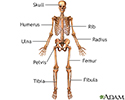Blount disease
Blount's disease; Tibia vara
Blount disease is a growth disorder of the shin bone (tibia) in which the lower leg turns inward, making it look like a bowleg.
Causes
Blount disease occurs in young children and adolescents. The cause is unknown. It is thought to be due to the effects of weight on the growth plate. The inner part of the shin bone, just below the knee, fails to develop normally.
Unlike bowlegs , which tend to straighten as the child develops, Blount disease slowly gets worse. It can cause severe bowing of one or both legs.
Bowlegs
Bowlegs is a condition in which the knees stay wide apart when a person stands with the feet and ankles together. It is considered normal in childre...
This condition is more common among African American children. It is also associated with obesity and early walking.
Symptoms
One or both of the lower legs turn inward. This is called "bowing." It may:
- Look the same on both legs
- Occur just below the knee
- Rapidly get worse
Exams and Tests
The health care provider will examine you. This will show that the lower legs turn inward. An x-ray of the knee and the lower leg confirms the diagnosis.
x-ray of the knee
A bone x-ray is an imaging test to look at the bones.

Treatment
Braces are used to treat children who develop severe bowing before the age of 3.
Surgery is most often needed if braces do not work, or if the problem is not diagnosed until the child is older. Surgery may involve cutting the shin bone to place it in the proper position. Sometimes, the bone will be lengthened as well.
Other times, surgery is done to restrict the growth of the outer half of the shin bone. This allows the child's natural growth to reverse the bowing process. This is a much smaller surgery. It works best in children with less severe symptoms who still have quite a bit of growing to do.
Outlook (Prognosis)
If the leg can be placed into the proper position, the outlook is good. The leg should work properly and look normal.
Possible Complications
Failure to treat Blount disease may lead to progressive deformity. The condition may lead to differences in leg lengths, which can result in disability if not treated.
Blount disease may come back after surgery, especially in younger children.
When to Contact a Medical Professional
Call your child's provider if your child's leg or legs appear to be bowing. Also call if your child has bowed legs that appear to be getting worse.
Prevention
Weight loss for overweight children may be helpful.
References
Canale ST. Osteochondrosis or epiphysitis and other miscellaneous affections. In: Azar FM, Beaty JH, Canale ST, eds. Campbell's Operative Orthopaedics . 13th ed. Philadelphia, PA: Elsevier; 2017:chap 32.
Kliegman RM, Stanton BF, St. Geme JW, Schor NF. Torsional and angular deformities. In: Kliegman RM, Stanton BF, St. Geme JW, Schor NF, eds. Nelson Textbook of Pediatrics . 20th ed. Philadelphia, PA: Elsevier; 2016:chap 675.
-
Anterior skeletal anatomy - illustration
The skeleton is made up of 206 bones in the adult and contributes to the form and shape of the body. The skeleton has several important functions for the body. The bones of the skeleton provide support for the soft tissues. For example, the rib cage supports the thoracic wall. Most muscles of the body are attached to bones which act as levers to allow movement of body parts. The bones of the skeleton also serve as a reservoir for minerals, such as calcium and phosphate. Finally, most of the blood cell formation takes places within the marrow of certain bones.
Anterior skeletal anatomy
illustration
-
Anterior skeletal anatomy - illustration
The skeleton is made up of 206 bones in the adult and contributes to the form and shape of the body. The skeleton has several important functions for the body. The bones of the skeleton provide support for the soft tissues. For example, the rib cage supports the thoracic wall. Most muscles of the body are attached to bones which act as levers to allow movement of body parts. The bones of the skeleton also serve as a reservoir for minerals, such as calcium and phosphate. Finally, most of the blood cell formation takes places within the marrow of certain bones.
Anterior skeletal anatomy
illustration
Review Date: 12/9/2016
Reviewed By: Neil K. Kaneshiro, MD, MHA, Clinical Assistant Professor of Pediatrics, University of Washington School of Medicine, Seattle, WA. Also reviewed by David Zieve, MD, MHA, Medical Director, Brenda Conaway, Editorial Director, and the A.D.A.M. Editorial team.

